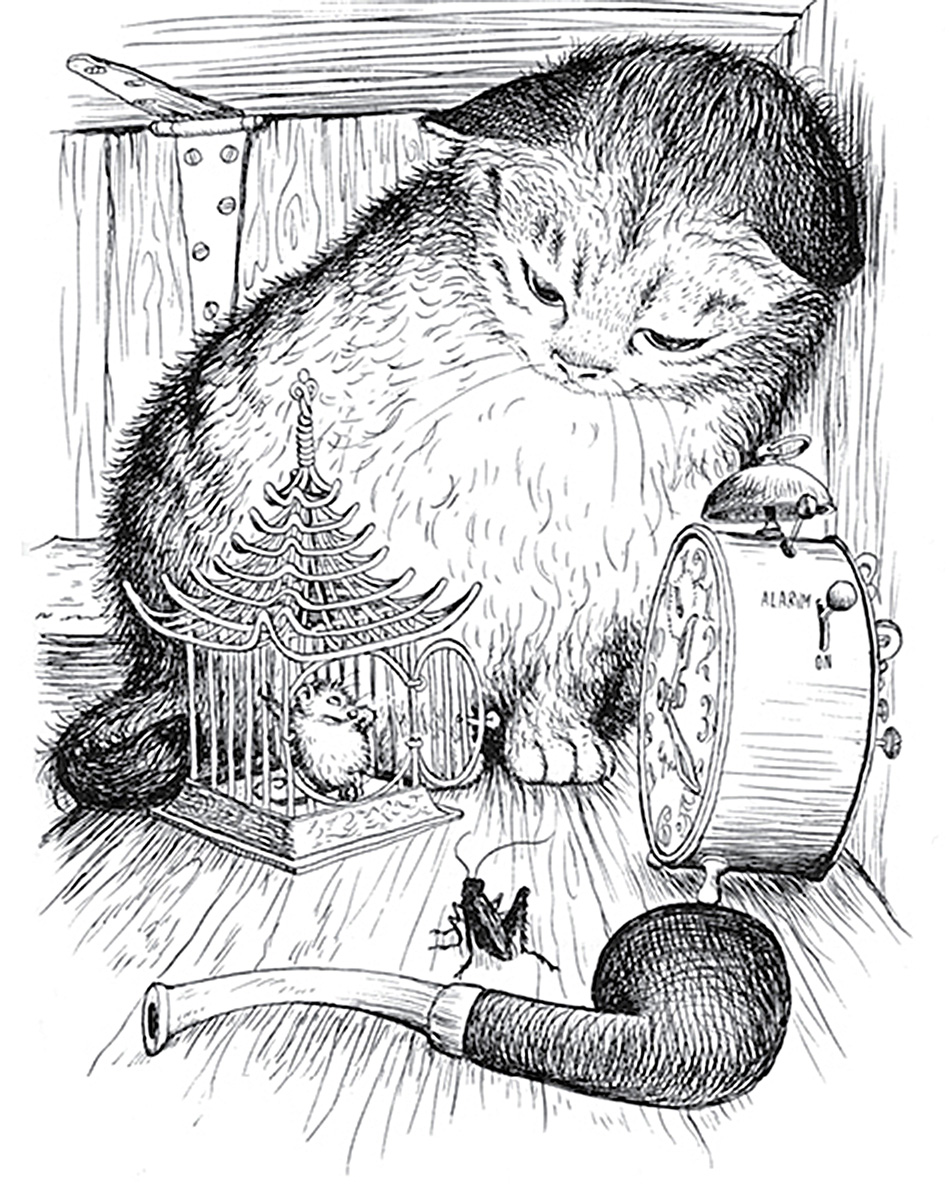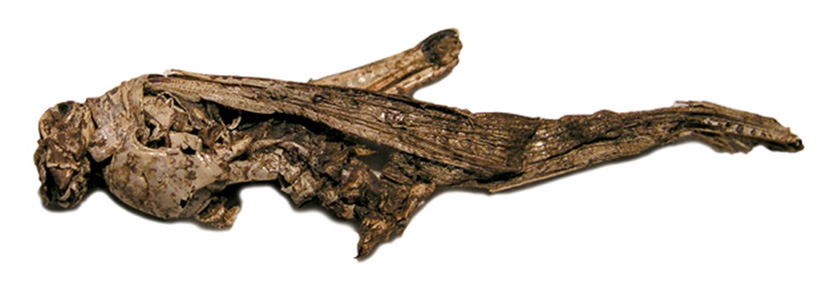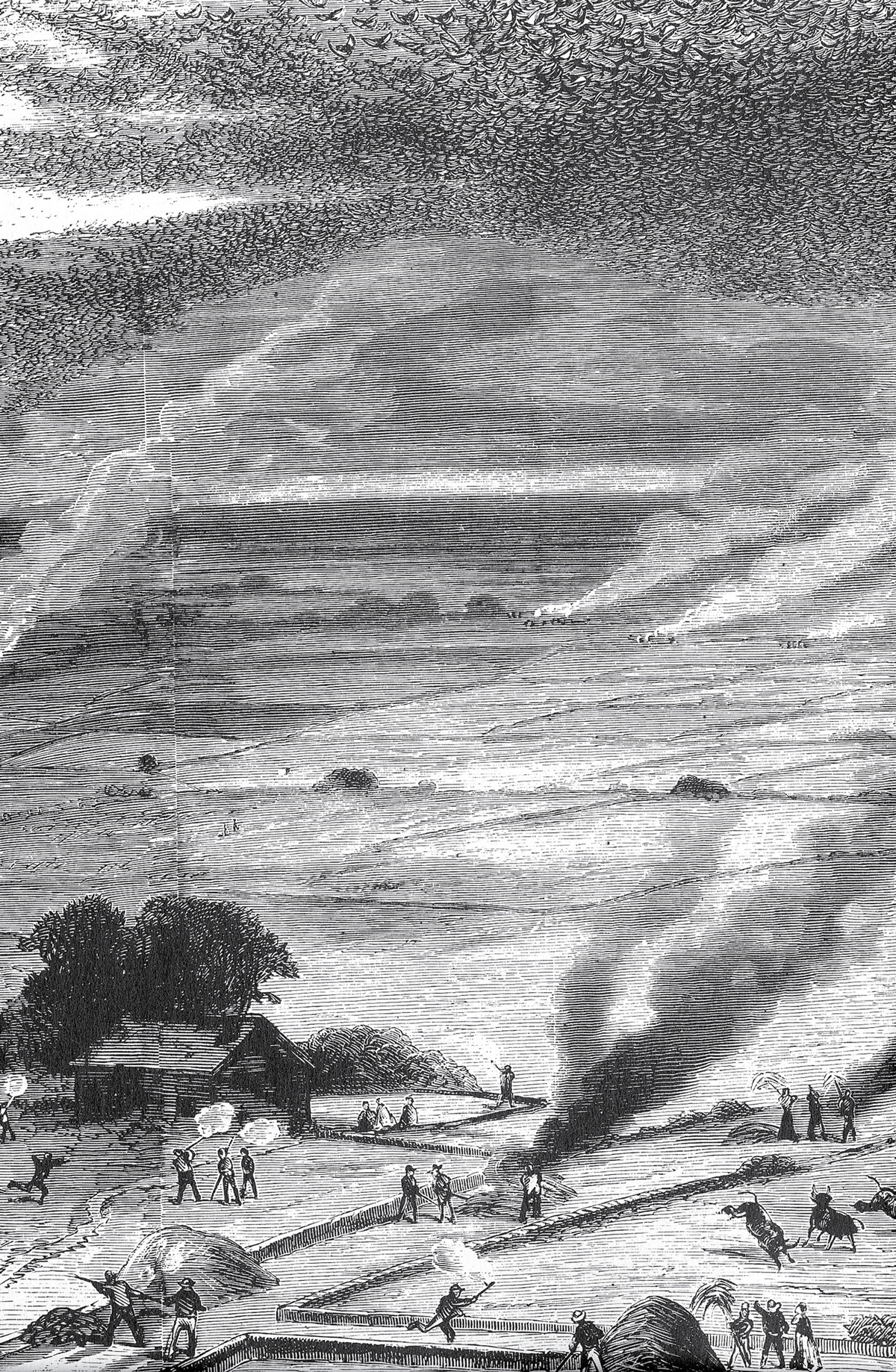Days of the Locust: An Interview with Jeffrey Lockwood
Inside the swarm
David Serlin and Jeffrey Lockwood
In the summer of 1875, an infestation of Rocky Mountain locusts measuring 198,000 square miles—a square 450 miles on each side, containing an estimated 3.5 trillion locusts—descended upon the midwestern United States, the largest locust swarm ever recorded. (By comparison, the second-largest swarm, in Kenya in 1954, covered fewer than one hundred square miles.) Although an unprecedented convergence of specific climatic, agricultural, and ecological conditions was responsible for creating the 1875 outbreak, many communities interpreted the locust swarm as an objective sign of pending apocalypse and confirmation that the modern world could not escape the wrath of an angry God. By the early years of the twentieth century, however, the Rocky Mountain locust, with its turbo-charged capacity for devastation and destruction, had vanished, leaving scientists, theologians, and historians to ponder the cause of its mysterious disappearance.
In his book Locust: The Devastating Rise and Mysterious Disappearance of the Insect that Shaped the American Frontier (Basic Books, 2004), Jeffrey Lockwood, professor of natural sciences and humanities at the University of Wyoming, encounters the legacy of the Rocky Mountain locust in a variety of settings, from nineteenth-century frontier diaries and newspaper accounts to Wyoming’s Knife Point Glacier, where the cadavers of the Rocky Mountain locust remain preserved in the ice. For Lockwood, the rise and fall of the Rocky Mountain locust, from terrestrial terror to frozen artifact, raises a host of questions about the dynamic relationship between human and insect worlds that we have yet to fully reconcile. David Serlin spoke with Lockwood by phone in January 2007.
Cabinet: In your book, you sometimes use the words grasshopper and locust interchangeably. When I hear the word grasshopper, I think of a sweet little summertime creature, but when I hear locust, the hairs on the back of my neck stand up. Do grasshoppers and locusts belong to the same species, or are there significant differences between the two?
Jeffrey Lockwood: A locust is basically a grasshopper that has evolved the capacity both to aggregate in large numbers as nymphs, and to swarm in large numbers as adults. Locusts not only behave differently than grasshoppers, but along with that behavior come transformations in physiology and, most spectacularly, in their color, size, and shape. In parts of the world where there have been irregular surges of plant growth—in Australia, in South America, and in parts of Africa and Asia—some grasshoppers have been able to track radically abundant food resources, and over time these grasshoppers evolved into what we would call locusts. This was certainly the case with the Rocky Mountain locust. It’s a Dr. Jekyll and Mr. Hyde sort of thing. Or maybe the analogy here is between a good kid and a juvenile delinquent.

You focus on the Rocky Mountain locust during the second half of the nineteenth century, but you also refer to less well-known historical moments when humans encountered problems with other varieties of locusts, such as in classical Greece and in medieval Europe, when locusts were even put on trial for their misdeeds and received heavy sentencing from local magistrates.
Locusts that invaded Europe in the Middle Ages put churches in an incredibly difficult dilemma. People wanted their local clergy to do something about it, and the church’s representative could say, “My intuition is that it’s the work of the devil, so what we have to do is to cast an anathema, or a curse, on them.” But if you look back at the Old Testament, you’ll see that locusts show up by the hand of God as well. So you have a theological dilemma: are locusts the work of the devil, or the work of God? It would probably be a bad move to curse God’s messengers, so you want to play this a little carefully.
If there hadn’t been occasional locust swarms in Europe, perhaps they would have had more of a mythical status. I think all of those invasions over time kept the cultural awareness of the locust alive as something that was real and imminent rather than something that was biblical legend or solely of the past. Many people coming to the Americas in the seventeenth and eighteenth centuries mistakenly referred to cicadas as locusts. It points out how the image of the locust was still fresh in the minds of European pioneers at that time.
I want to read a sentence from your book: “The psychological trauma of the locusts, the capriciousness of their arrival, the magnitude of their swarms, and the voracity of their feeding, became embedded in the lives and language of the frontier.” How was it for you to read nineteenth-century accounts of locust swarms?
In a very real sense, the research was facilitated by the vivid language that was used by the settlers in journals and letters in which they communicated utter despair and the sense of being overwhelmed by nature. A person named E. Snyder, for example, from Highland, Kansas, wrote a letter to a relative and described one swarm like this: “[The locusts] came rattling and pattering on the houses, and against the windows, falling the fields, on the prairie—everywhere and on everything. By about 4 o’clock in the afternoon, every tree and bush, buildings, fences, fields, roads, and everything, except animated beings, was completely covered with grasshoppers,” by which the letter-writer meant the Rocky Mountain locust. In just a few words, Snyder painted a horrific portrait of locust invasion, and you can’t help but be drawn into that sense of helplessness. This wasn’t even the 1875 swarm, the scale of which must have been almost inconceivable—unless, I suspect, you were in the middle of it.
Many new denominations, from Mormons to evangelicals, interpreted the locust not just as a devouring stranger but also as a sentinel of sin, which forced religious people to think about the wrath of God in a completely different way.
Rather ironically, the Rocky Mountain locust did many of these newly-emerging Christian religions a favor in that it provided a deep connection back to a biblical literalism that linked the New World profoundly to the Old World, so that these religions took on an urgency and an authenticity that they might not have had otherwise. It’s as if those who witnessed these locust swarms could say, “Even though the modern industrial world is a complicated place, the wrath of God can still be as brutal and as unforgiving as it was in the days of the Old Testament.” In this way, the locust re-routed people back to one of the few things of which they were certain: a faith in God that provided a modicum of familiarity in terms of deep roots into their religious traditions.
The situation speaks to the desire to impute meaning or intention to a world in which we suspect, and perhaps fear, there isn’t always purpose, meaning, and intention. I also think it speaks to a profound psychological need to believe that if we do the right thing and lead a good life, then we’ll be rewarded. So, when we see a bad thing happen to another person, we want to believe that they did something to deserve it. Here were settlers engaged in America’s version of the exodus, doing all the right things, living the Jeffersonian ideal, making the land productive, and all of it looks like goodness and abundance. They must be the blessed people. But then they get hammered by the locusts. You can have only two interpretations: either people must have done something to deserve it, or really bad things can happen for no good reason.

In your book, you identify some of the industrial solutions proposed by nineteenth-century inventors to combat the wrath of the locust. You describe some of these locust-fighting technologies as “the result of the creative conspiracy between Rube Goldberg and the Marquis de Sade.”
There were multiple technologies that were used to fight locusts, but the dominant technology by and large was the machine. Americans had faith that they could battle the locust through Yankee ingenuity. They believed that the Industrial Revolution was the pinnacle of human progress, so they built all of these staggeringly clever, though completely ineffective, devices. The machines didn’t do very much except provide people with a sense of control and hopefulness—and that can be very important to surviving a disaster. If you fast-forward to the 1950s and 1960s, there were still plenty of pest outbreaks, but we were no longer in the machine age; we had entered the age of better living through chemistry, and the development of pesticides like DDT was the logical response to controlling insects. Then, in a period of about forty years, locust management on a worldwide basis moved from chemistry to information technology: satellites, remote sensing surveys, and so forth. Today’s technology tries to solve a problem that hadn’t been previously solved using either chemistry or machinery. What technology really offers us is the appearance of control and a sense of hope in the face of that which may well be ultimately uncontrollable.

How did your visit to Wyoming’s Knife Point Glacier, or what is sometimes called “Grasshopper Glacier,” confirm or challenge the kind of history of the locust that you had been trying to tell up until that point?
My visit to Grasshopper Glacier was motivated by a genuine interest in science and the capacity of those frozen specimens to shed some light on the history and the cause of the demise of the Rocky Mountain locust. Before my trip, I had been, through my readings, a vicarious observer of the swarms, but none of my knowledge had been firsthand. That’s why finding the frozen bodies of locusts on Knife Point Glacier was such a thrill. It was a personal vindication, given the number of naysayers within science as to whether any evidence of this particular nineteenth-century strain of the Rocky Mountain locusts could be found. When I saw the sheer amount of biological material embedded in the glacier—now melting out of it—I had a better sense of the scale of what these swarms must have been like. There are probably many more layers of locusts still frozen in the ice, though my understanding is that the climatologists and geologists are predicting that the glaciers of the Rocky Mountains are going to be completely gone in thirty to fifty years. Presumably it’s not only the story of the Rocky Mountain locust, which goes back hundreds and thousands of years, which will be lost forever; those glaciers, and their various strata, must have other stories locked away as well.
From the glacial material, we established that the Rocky Mountain locust was not an extinct form of a still-existing species but was in fact an extinct species, and this realization was very difficult for scientists to get their head around: how could something that once existed in such staggering quantities have disappeared in such a short period of time? A lot of people still harbored suspicions that it wasn’t really a true species, and that it must have been this bizarre phase of some existing species.
Like killer bees? I remember being a kid in the 1970s and watching reports about killer bees and thinking that they signaled the end of the world as we know it.
That’s an interesting parallel, because many people think of the grasshopper as an innocent, harmless, meadow-munching kind of creature. Think about Jiminy Cricket from Pinocchio or Chester the Cricket from The Cricket in Times Square. Then Jiminy and Chester turn on us. Maybe there’s that sort of reaction with the bees. We all know that they sting, but there’s this sense that if you leave them alone, they’re harmless and industrious. Our parents tell us that if you don’t hurt bees, they won’t hurt you. The killer bee is to our image of bees what the Rocky Mountain locust is to our image of grasshoppers. The locust is the Steppenwolf of the grasshopper family.
Are there people who would like to revive the Rocky Mountain locust? Are there any scientific or commercial applications for which the Rocky Mountain locust or one of its more pernicious cousins would be useful?
I suspect that there are many scientists who would like nothing better than to have a living colony of the Rocky Mountain locust for a whole range of reasons. Of course, the number who would like them as a laboratory colony is probably far greater than those who would like them as an extant species in the natural world, especially if the insects went back to their dastardly deeds. There is probably some misanthropic strain of scientists, perhaps including me in my darker moments, who would say that if the Rocky Mountain locust did come back, it would be a solid reminder that our sense of control is always in question. In North America, we believe that we’ve beaten the insects and, except for the summer cicada, we don’t have any reminders of the sweep of the biological world. Perhaps some of the members of the environmental and conservation communities would say that the return of the locust would be in miniature the return of an ecological process that’s been lost. There are those who made that argument with regard to wolves, which were seen as a missing part of the natural process, but the Rocky Mountain locust probably played a far greater role in ecological processes than wolves ever did.

So would you argue that there were benefits to having the Rocky Mountain locust as part of the ecological world? Did they provide any kind of balance in a much more contained environmental cycle?
Even the in the nineteenth century, people observed that the crops in the years following locust invasions were abnormally abundant. It probably had to do with the enormous amount of organic material that the locusts added on a local basis to the soil. In one way we can think of locusts as a short-term disaster and a long-term benefit. They were a phenomenal source of free fertilizer in an era in which production was often limited by nutrients. Even today, the net addition of both carbon and nitrogen to relatively poor soils in Africa via a locust swarm is a tremendous boon for local agriculture. The key is to enable people to survive the destruction of a given year’s crop because the longer-term ecological benefits are so significant. Our inability to appreciate the difference between short-term and long-term gain is something that pops up often in our lives, in our society, and in how we make trade-offs. Consider global warming and how the short-term costs of moving toward an economy not based on fossil fuel are balanced against the long-term gains that we might achieve. Some version of that story plays out in how we interpret locust swarms.
Jeffrey Lockwood is professor of natural sciences and humanities at the University of Wyoming, where he divides his time between the Department of Philosophy and the MFA program in creative writing. He is the author of Locust: The Devastating Rise and Mysterious Disappearance of the Insect that Shaped the American Frontier (Basic, 2004) and is currently writing a book on the history of the use of insects as weapons of war, terrorism, and torture, forthcoming from Oxford University Press.
David Serlin is associate professor of communication and science studies at the University of California, San Diego, and an editor-at-large for Cabinet. He is the author of Replaceable You: Engineering the Body in Postwar America (University of Chicago Press, 2004).